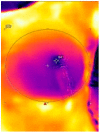Assessment of Mastectomy Skin Flaps for Immediate Reconstruction with Implants via Thermal Imaging-A Suitable, Personalized Approach?
- PMID: 35629162
- PMCID: PMC9145421
- DOI: 10.3390/jpm12050740
Assessment of Mastectomy Skin Flaps for Immediate Reconstruction with Implants via Thermal Imaging-A Suitable, Personalized Approach?
Abstract
Background: Impaired perfusion of the remaining skin flap after subcutaneous mastectomy can cause wound-healing disorders and consecutive necrosis. Personalized intraoperative imaging, possibly performed via the FLIR ONE thermal-imaging device, may assist in flap assessment and detect areas at risk for postoperative complications.
Methods: Fifteen female patients undergoing elective subcutaneous mastectomy and immediate breast reconstruction with implants were enrolled. Pre-, intra- and postoperative thermal imaging was performed via FLIR ONE. Potential patient-, surgery- and environment-related risk factors were acquired and correlated with the occurrence of postoperative complications.
Results: Wound-healing disorders and mastectomy-skin-flap necrosis occurred in 26.7%, whereby areas expressing intraoperative temperatures less than 26 °C were mainly affected. These complications were associated with a statistically significantly higher BMI, longer surgery duration, lower body and room temperature and a trend towards larger implant sizes.
Conclusion: Impaired skin-flap perfusion may be multifactorially conditioned. Preoperative screening for risk factors and intraoperative skin-perfusion assessment via FLIR ONE thermal-imaging device is recommendable to reduce postoperative complications. Intraoperative detectable areas with a temperature of lower than 26 °C are highly likely to develop mastectomy-skin-flap necrosis and early detection allows individual treatment concept adaption, ultimately improving the patient's outcome.
Keywords: mastectomy-skin-flap necrosis; mastectomy-skin-flap perfusion; personalized medicine; reconstructive breast surgery; thermal imaging.
Conflict of interest statement
The authors declare no conflict of interest.
Figures



Similar articles
-
Indocyanine green angiography for preventing postoperative mastectomy skin flap necrosis in immediate breast reconstruction.Cochrane Database Syst Rev. 2020 Apr 22;4(4):CD013280. doi: 10.1002/14651858.CD013280.pub2. Cochrane Database Syst Rev. 2020. PMID: 32320056 Free PMC article.
-
Intraoperative perfusion mapping with laser-assisted indocyanine green imaging can predict and prevent complications in immediate breast reconstruction.Plast Reconstr Surg. 2010 Apr;125(4):1065-1073. doi: 10.1097/PRS.0b013e3181d17f80. Plast Reconstr Surg. 2010. PMID: 20335859
-
Skin-reducing mastectomy and one-stage implant reconstruction with a myodermal flap: a safe and effective technique in risk-reducing and therapeutic mastectomy.J Plast Reconstr Aesthet Surg. 2013 Sep;66(9):1188-94. doi: 10.1016/j.bjps.2013.04.048. Epub 2013 May 8. J Plast Reconstr Aesthet Surg. 2013. PMID: 23664385
-
The ability of intra-operative perfusion mapping with laser-assisted indocyanine green angiography to predict mastectomy flap necrosis in breast reconstruction: a prospective trial.J Plast Reconstr Aesthet Surg. 2014 Apr;67(4):449-55. doi: 10.1016/j.bjps.2013.12.040. Epub 2013 Dec 31. J Plast Reconstr Aesthet Surg. 2014. PMID: 24507962
-
Intraoperative Perfusion Assessment in Mastectomy Skin Flaps: How Close are We to Preventing Complications?J Reconstr Microsurg. 2019 Sep;35(7):471-478. doi: 10.1055/s-0039-1679958. Epub 2019 Feb 21. J Reconstr Microsurg. 2019. PMID: 30791063 Review.
Cited by
-
Perfusion in Pedicled Skin Flaps: Initial Insights from Smartphone-Based Thermal Imaging Protocol.J Pers Med. 2024 Jul 5;14(7):730. doi: 10.3390/jpm14070730. J Pers Med. 2024. PMID: 39063984 Free PMC article.
-
Point-of-Care Tissue Oxygenation Assessment with SnapshotNIR for Alloplastic and Autologous Breast Reconstruction.Plast Reconstr Surg Glob Open. 2023 Jul 11;11(7):e5113. doi: 10.1097/GOX.0000000000005113. eCollection 2023 Jul. Plast Reconstr Surg Glob Open. 2023. PMID: 37441113 Free PMC article.
-
A Comprehensive Scoping Review on the Use of Point-Of-Care Infrared Thermography Devices for Assessing Various Wound Types.Int Wound J. 2025 Aug;22(8):e70741. doi: 10.1111/iwj.70741. Int Wound J. 2025. PMID: 40819851 Free PMC article. Review.
-
Evaluation of the Influence of Short Tourniquet Ischemia on Tissue Oxygen Saturation and Skin Temperature Using Two Portable Imaging Modalities.J Clin Med. 2022 Sep 5;11(17):5240. doi: 10.3390/jcm11175240. J Clin Med. 2022. PMID: 36079169 Free PMC article.
-
Special Issue "Plastic and Reconstructive Surgery in Personalized Medicine".J Pers Med. 2023 Mar 22;13(3):569. doi: 10.3390/jpm13030569. J Pers Med. 2023. PMID: 36983750 Free PMC article.
References
LinkOut - more resources
Full Text Sources

